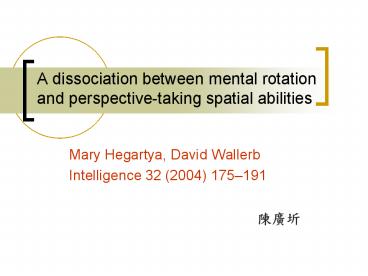A dissociation between mental rotation and perspectivetaking spatial abilities - PowerPoint PPT Presentation
1 / 25
Title:
A dissociation between mental rotation and perspectivetaking spatial abilities
Description:
Spatial visualization (mental rotation) object-based spatial transformations ... Object Perspective Test was found to be dissociable from mental rotation, ... – PowerPoint PPT presentation
Number of Views:129
Avg rating:3.0/5.0
Title: A dissociation between mental rotation and perspectivetaking spatial abilities
1
A dissociation between mental rotation and
perspective-taking spatial abilities
- Mary Hegartya, David Wallerb
- Intelligence 32 (2004) 175191
???
2
Spatial Ability
- Spatial visualization (mental rotation)
- object-based spatial transformations
- Spatial orientation
- egocentric spatial transformations
- imagine the appearance of objects from
different orientations (perspectives) of the
observer
3
Psychomatric literature
- Spatial orientation separable from spatial
visualization - Many studies have questioned this distinction
4
Experimental cognitive literature
- Imagining either a rotation of the array or a
rotation of themselves around the array - Same degree but not equivalent in difficulty
- Object rotations show a linear increase in
response time as a function of angle of rotation,
whereas self-rotations do not always show this
pattern - Different neural structures
5
- So-called tests of spatial orientation are not
always solved by a perspective-transformation
strategy
6
Strategies
- Object-based mental rotation strategy
- Perspective-taking strategy
- Analytic strategy
7
Kozhevnikov and Hegarty (2001)
8
- Dominant strategy used to solve the test items
was to imagine themselves reoriented with respect
to the display (7/8) - True tests of spatial orientation ability
- Dissociable from measures of spatial
visualization ability
9
Experiment
- Relation to two other tests of perspective taking
- Money road map test primarily by an
egocentric spatial transformation strategy - New perspective-taking test
- Separable from tests of mental rotation
specifically - Mental rotation tests predominantly by an
object-based transformation strategy
10
Analyze
- Analyzed performance on tests of
perspective-taking and mental rotation abilities
using CFA - Confirmatory Factor Analysis
- Impose a particular model on the data and examine
how well the model fits
11
Method
- 62 participants (undergraduate)
- Mental rotation ability
- Card Rotation Test
- Flags Test
- Vandenberg Mental Rotations Test
12
Method
- Perspective-taking ability
- Object Perspective Test
- Money Road Map Test
- Pictures Test
13
Money Road Map Test
- Schultz (1991) found that 80 of
- participants reported using a
- perspective-taking strategy
- on this task, and that use of this
- strategy was associated with
- higher scores on the test
14
Pictures Test
- 30 multiple-choice items, grouped in 10 sets of 3
- The test was scored as the number correct minus
one-third of the number wrong
15
Procedure
- Pictures Test
- Vandenberg Mental Rotations Test
- Money Road Map Test
- Flags Test
- Object Perspective Test
- Card Rotations Test
16
Results
- Values of any variable that were greater or less
than 3 standard deviations from the mean were set
to be equal to 3 standard deviations above or
below the mean
17
Results
- Reliabilities for the Object Perspective and
Pictures Tests, based on this administration of
the tests were .79 and .73, respectively
(Cronbachs alpha statistic) - Scores on this variable were linearly transformed
(by subtracting the average error score from
180)
18
Results
- First tested a model assuming that the six
spatial abilities tests load on a single spatial
abilities factor
19
Single Factor V.S. Two Factor
- Significant ?2 indicating a poor fit to the data
- ?2 /df statistic, with a value less than 2.0
indicating a good fit - RMSEA a value of .08 or below indicates a fair
fit, and a value no higher than .05 indicates a
good fit - CFI of at least .9 indicating a fair fit and a
value of at least .95 indicating a good fit to
the data
V
V
V
20
Results
- Three of the four indices suggest that the
two-factor model - fit the data well
21
Discussion
- Revised version of the Object Perspective Test is
reliable - Provides evidence for its validity as a test of
spatial orientation ability - The new Object Perspective Test loaded on the
same factor as the Money Road Map Test, which is
solved primarily by a perspective-taking strategy
22
Discussion
- This provides evidence for the convergent
validity of the Object Perspective Test - Object Perspective Test was found to be
dissociable from mental rotation, providing
evidence for discriminant validity
23
Discussion
- The ability to make egocentric spatial
transformations and the ability to make
object-based spatial transformations are somewhat
dissociable - Two spatial factors are highly correlated
(r.80), indicating that they have considerable
shared variance
24
Discussion
- Rely on many common processes, such as the
ability to encode spatial images and ability to
maintain these representations in memory - Variability in the strategies used to solve all
spatial tests - Different cognitive operations, does not
necessarily imply that there will be no
correlation
25
Thanks For Your Attention!!































